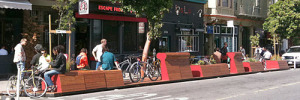Arguably the most adorable urban space to come along in a long time, parklets are to Golden Gate and Griffith parks what amoebas are to elephants. They are multiplying, not by mitosis but by entrepreneurship, all over San Francisco – with Oakland, Long Beach, and other cities in California and elsewhere showing interest in the notion that parking spaces aren’t just for cars anymore.
Nevada Threatens Secession from Tahoe Compact
After 31 years as a supposedly equal party in the Bi-State Compact governing the Lake Tahoe basin, Nevada has taken its first steps towards pulling out of the Tahoe Regional Planning Agency.
Proposed ‘New City’ Banks on Resurrection of Salton Sea
Travertine Point would cover roughly 5,000 acres along the northwest corner of the Salton Sea, roughly 10 miles from Mecca and 35 miles from Palm Springs.
Culture of Planning: A Panel of Practitioners Explores the Civics of City Planning in Los Angeles
The L.A. chapter of the American Institute of Architects recently convened a panel titled “Civic Affairs and the Culture of City Planning.” The panel, which considers some of the most relevant planning issues facing the city, was moderated by TPR Editor Emeritus Josh Stephens.
Every City For Itself: Adapting to Climate Change
A great deal of literature has already anointed the hero in the fight against climate change: the city. Beginning with David Owens’ Green Metropolis and including the work of Paul Hawken, Ed Glaeser, and countless …
Deconstructing A Tea Party Muse
For some lucky candidates, tomorrow’s election will have a storybook ending. Unfortunately for anyone who understands architecture, planning, and land use, that storybook will, in many cases, turn out to be The Fountainhead.
Epic S.F. Redevelopment Wins Approval
Replacing the former drydocks and heavy industrial facilities on the southern, bayside edge of San Francisco will be up to 10,000 units of housing as well as 5 million square feet of commercial space and and 300 acres of green spaces.
Irvine Embraces Infill
A new vision plan recently completed by the City of Irvine signals a major shift away from the suburban lifestyle of Orange County.
Transit Agencies Find New On-Ramps to the Information Superhighway
Social media’s stock on the rise as a tool to reach the public
Joel Kotkin Anticipates How California Will Handle Its Share Of ‘The Next 100 Million’
In his latest book, The Next 100 Million: America in 2050, Los Angeles-based author and urbanist Joel Kotkin discuses who these 100 million new Americans are going to be, where they are going to live, and what type of lifestyles they will lead.
Placemaking for Pot Smoking
What the Regulate, Control and Tax Cannabis Act of 2010 does not do is prescribe how cannabis should be regulated, controlled, and taxed. Nor does it dictate where pot can be sold or grown. It leaves those complex decisions up to cities and counties, which many consider both a blessing and a curse.
Transit Agencies Find New On-Ramps to the Information Superhighway
Social Media’s Stock on the Rise As a Tool to Reach the Public
AB 32 Backlash Clouds Future of Smart Growth
As public support for global warming mitigation is faltering, the state’s economy remains stuck in neutral, and developments are dying on the vine, California’s landmark environmental legislation is under attack.
Putting Parking into Reverse
As parking requirements facilitate the use of cars, total travel increases, public transit use decreases, buildings scoot farther away from each other, density diminishes, central cities go into tailspins and sprawl increases-all of which, in turn, increases the need for more parking.
You Can’t Spell Subsidy Without B-U-S
A certain radical fringe contends that the benefits of free transit — that is, transit with a 100 percent subsidy (a la schools) — would pay for itself many times over. That might sound a little nuts, except that it’s hard to define a substantive difference between the argument in favor of fare-free transit and that in favor of toll-free roads.
Starchitecture and Sustainability: Hope, Creativity, and Futility Collide in Contemporary Architecture
The question remains whether this functional movement also calls for a new formal movement, displaying materials and designs that hew towards ecological goals rather than individual visions. Uneasy about the prospect of privileging efficiency over art, many of today’s starchitects say no.
Starchitecture and Sustainability: Hope, Creativity, and Futility Collide in Contemporary Architecture
Whether the prosaic goals of the environmental movement can commingle with those of high art remains to be seen.
